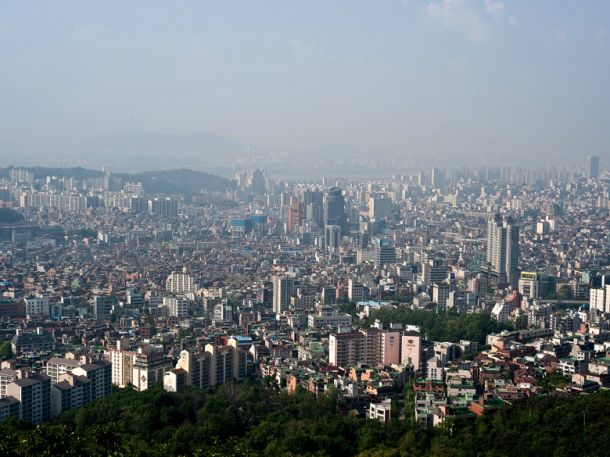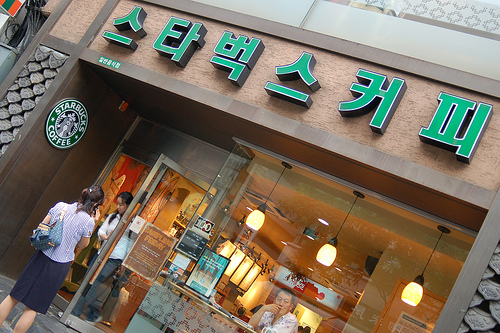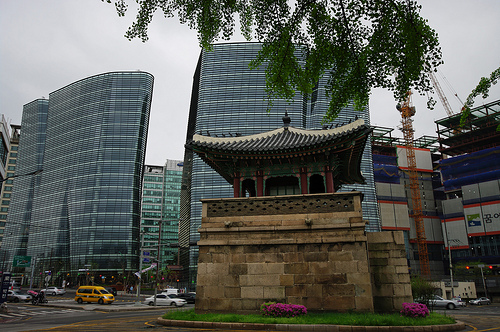
The Korean Peninsula has historically been filled with a homogeneous society, but recently Seoul has been making strides to become a global city. The recent tourism program, the rising number of English academies, and new progress initiatives for international business, Seoul is working hard to offer up the best of itself to the world. This city, that only 60 years ago was devastated by the Korean War, has impressively risen to become the 10th most economically powerful city in the world and intends to keep growing. With all of this recent attention, Seoul must now learn to adapt to growing globalization within its own borders.
Seoul: The Heartbeat of a Nation
Flying into “the land of the morning calm” is a pleasure in itself. The Incheon International Airport prides itself for being rated the number one airport in the world for the past five years by the ACI. Many people plan on getting to the airport far in advance or schedule a long layover purposefully to enjoy the exorbitant amenities such as a golf course, skating rink, casino, the Museum of Korean Culture, high-end spas and shops, and restaurants serving any food you could hope for. It is the perfect prelude for the city that awaits.
Seoul is an ever-bustling city full of history, high technology, exciting nightlife, and abundant shopping. Home to citizens ranging from those who remember the perils of the war, to a young, consumer-heavy, technology-driven generation, the capital city is filled with a mix of preserving old traditions and creating new ones. Living for a year just outside of the mega-city of Seoul, South Korea, I made frequent trips to this city of 10 million people, which comprises a fifth of the total population of the nation.Koreans are blowing up on the world scene because they are innovative, efficient and hard working. Apartments in Seoul can now be controlled from cell phones, and facial recognition programs will soon be introduced to security systems. Seoul is ranked number one in the world for wireless connectivity, with 95% of households using broadband connection. This city is plugged-in and ready for the world.
Internationals in Seoul
Internationals living in Seoul are typically involved in business, education or stationed with the US military. However, seeing way-gook, or foreigners, is still relatively uncommon outside of specific areas for tourism or business. Seoul officials have stated that only 255,501 foreigners of 152 countries lived in Seoul as of 2010, a substantial growth of over 200,000 since 1998, yet still a long way from becoming a truly diverse city. Itaewon is the most condensed area for foreigners within Seoul. Popular international food markets and restaurants with cuisine hailing from South Africa to the Middle East to Australia and more make it an interesting cultural mix in such a homogenous nation.With the growth of internationals living and touring the capital, Seoul is taking several steps to create a global environment. The city has designated five Global Village Zones providing language-barrier free places to help foreigners adapt and live more comfortably. The zones offer multicultural lectures, expatriate events and administrative support. While benefiting expatriates is a goal, global city status will ultimately aim to help Seoulites grow economically and socially as well. One of the next steps to catering to foreigners will be improving the immigration policy. In the past, Korea has made things difficult for foreigners, but with a plummeting birth rate and new opportunities for foreign investment, rules may need to change. New Yorkers will find that the cost of living in Seoul is drastically lower than in New York. Rent is typically three times lower than the cost of a place in NYC and necessities such as metro passes, food, internet and cell phone plans are much lower as well. However, the price of luxury and name brand items are much higher. What is the hottest luxury item in demand? Coffee. Since Starbucks came to Seoul in 1999, the price for a cup of coffee went from 300 won (approx. $0.28) to 5,000 won (approx. $4.73). In only the five years between 2006 to 2011, the Korean coffee industry grew tenfold, making coffee shops the top place for dates and gatherings. Coffee shops have become status symbols, creating a surge of youth who will scrimp on dinner, but pay six dollars for a Starbucks latte.
New Yorkers will find that the cost of living in Seoul is drastically lower than in New York. Rent is typically three times lower than the cost of a place in NYC and necessities such as metro passes, food, internet and cell phone plans are much lower as well. However, the price of luxury and name brand items are much higher. What is the hottest luxury item in demand? Coffee. Since Starbucks came to Seoul in 1999, the price for a cup of coffee went from 300 won (approx. $0.28) to 5,000 won (approx. $4.73). In only the five years between 2006 to 2011, the Korean coffee industry grew tenfold, making coffee shops the top place for dates and gatherings. Coffee shops have become status symbols, creating a surge of youth who will scrimp on dinner, but pay six dollars for a Starbucks latte.
Tourism: More Than Just Kimchi
Based on population, Seoul and NYC are relatively the same size, bustling metropolitan cities. As fascinating as the history of NYC may be, there is still something special about visiting a place far older. The famous Gyeongbokgung Palace, first constructed in year 1395, sits facing the 20th century high rises. History suddenly has a new perspective. Despite this historical area, the Korean peninsula has not typically been a hot-spot tourist destination. Neighboring China has drawn tourists for centuries with wonders such as the Great Wall, but having North Korea as an unpredictable neighbor and enemy has left many tourists feeling uneasy about risking a visit to Seoul. To ease fears within the city, a Tourist Police System has been established by the National Police Agency in association with the Ministry of Culture, Sports and Tourism. The 100 tourist police officers protect tourists from theft or being ripped off while visiting. Clashes are inevitable as tourism grows and encounters with internationals become common. Seoul may need to look to New York’s diversity for lessons as it works through the growing pains.
While battling issues of location, Seoul is making strides to show the world what it has to offer. Once a giant landfill, Seoul’s Digital Media City is being constructed as an electronic mecca for broadcasting, film production, video games, e-learning, and more. The 133-floor building, due for completion in 2015, will become the second tallest building in the world after Dubai’s Burj Khalifa.Now, between the success of PSY’s Gangnam Style, the lure of world-class plastic surgery, and popular television dramas, Seoul’s tourism has risen from 6 million visitors in 2005 to 11 million in 2012. Numbers are expected to grow to 15 million by 2015. Some of the increase may have come from government efforts in the launch of the Visit Korea campaign for 2010-2012. The main attraction for this campaign was the 2012 World Expo held in Yeosu. South Korea constructed a huge complex to house a new aquarium, technology structures, an interactive digital gallery, the “Big O” multi-media light show and dozens of creative exhibits for nations around the world. A special train station was built on the complex to help shuttle visitors of Seoul to the expo quickly and easily over its 6-month duration. Now, South Korea is beginning to make preparations for the 2018 Winter Olympics and the tourism boom that will ensue.
World Recognition: High Tech Fever
The tiny nation, roughly the size of the state of Kentucky, is packed with 50 million people ( for comparison, Canada’s population is 35 million) who have worked tirelessly to build the 17th largest economy in the world. Like New Yorkers, many Koreans I met had long commutes and worked long days at busy offices. Though they are busy, Koreans are generally proud of their hard work and believe it has been paying off and making their country a world player. This year, South Korea has been rated second in Bloomberg’s list of the 50 Most Innovative Countries.  Startup companies are popping up in Seoul, nearly doubling in 2012 to 28,193. Kakaotalk, a messaging service that allows users to chat, talk, and play games is one of Korea’s most successful startup companies. The company has over 94million users and continues to grow. Seoul has a community of entrepreneurs and venture capitalists who are growing more confident in this era of the internet boom and willing to take more risks. Young entrepreneurs are well-traveled, internationalized and bilingual trendsetters and they are eager for success.Even with the rise in numbers, Seoul still has a lot to learn from the New York’s Silicon Alley. The cultural differences of the concept of failure may be holding Koreans back from their success. David Lee, previously a Google executive, is a Co-founder of Seoul Space, a startup incubator and consultancy based in Seoul. He says there is a dire need for successful tech startups to be developed in Korea: “…a failure in startups in the US is considered a good experience, whereas in Korea a startup failure is just a failure. In this sense, startups are particularly a very risky proposition in Korea.” Richard Min, Lee’s partner at Seoul Space, led a discussion at the 2013 South by Southwest Conference. He spoke of the fear of failure in Korean culture, but also that this mindset is changing as promising entrepreneurs are rising. He believes Seoul startups will soon be some of the leaders in the global market, with some even embracing the nickname “Seoulicon Valley.”The government is also taking notice of the potential of startups. South Korean President Park Geun-Hye met with Mark Zuckerberg of Facebook, and has decided that nurturing startups will be central to her new growth initiatives. The South Korean government offered $2.9 billion in funding to tech venture startups. The South Korean Ministry of Justice announced they will be revising the “Enforcement Decree of the Immigration Control Act,” which could include granting startup visas to foreigners for better facilitation of foreign investment in Korea. This revision could mean great news for the foreign startup community. The potential in Seoul is high and rising and the Korean startup scene may be the perfect relationship for New York companies to begin to build.
Startup companies are popping up in Seoul, nearly doubling in 2012 to 28,193. Kakaotalk, a messaging service that allows users to chat, talk, and play games is one of Korea’s most successful startup companies. The company has over 94million users and continues to grow. Seoul has a community of entrepreneurs and venture capitalists who are growing more confident in this era of the internet boom and willing to take more risks. Young entrepreneurs are well-traveled, internationalized and bilingual trendsetters and they are eager for success.Even with the rise in numbers, Seoul still has a lot to learn from the New York’s Silicon Alley. The cultural differences of the concept of failure may be holding Koreans back from their success. David Lee, previously a Google executive, is a Co-founder of Seoul Space, a startup incubator and consultancy based in Seoul. He says there is a dire need for successful tech startups to be developed in Korea: “…a failure in startups in the US is considered a good experience, whereas in Korea a startup failure is just a failure. In this sense, startups are particularly a very risky proposition in Korea.” Richard Min, Lee’s partner at Seoul Space, led a discussion at the 2013 South by Southwest Conference. He spoke of the fear of failure in Korean culture, but also that this mindset is changing as promising entrepreneurs are rising. He believes Seoul startups will soon be some of the leaders in the global market, with some even embracing the nickname “Seoulicon Valley.”The government is also taking notice of the potential of startups. South Korean President Park Geun-Hye met with Mark Zuckerberg of Facebook, and has decided that nurturing startups will be central to her new growth initiatives. The South Korean government offered $2.9 billion in funding to tech venture startups. The South Korean Ministry of Justice announced they will be revising the “Enforcement Decree of the Immigration Control Act,” which could include granting startup visas to foreigners for better facilitation of foreign investment in Korea. This revision could mean great news for the foreign startup community. The potential in Seoul is high and rising and the Korean startup scene may be the perfect relationship for New York companies to begin to build.

